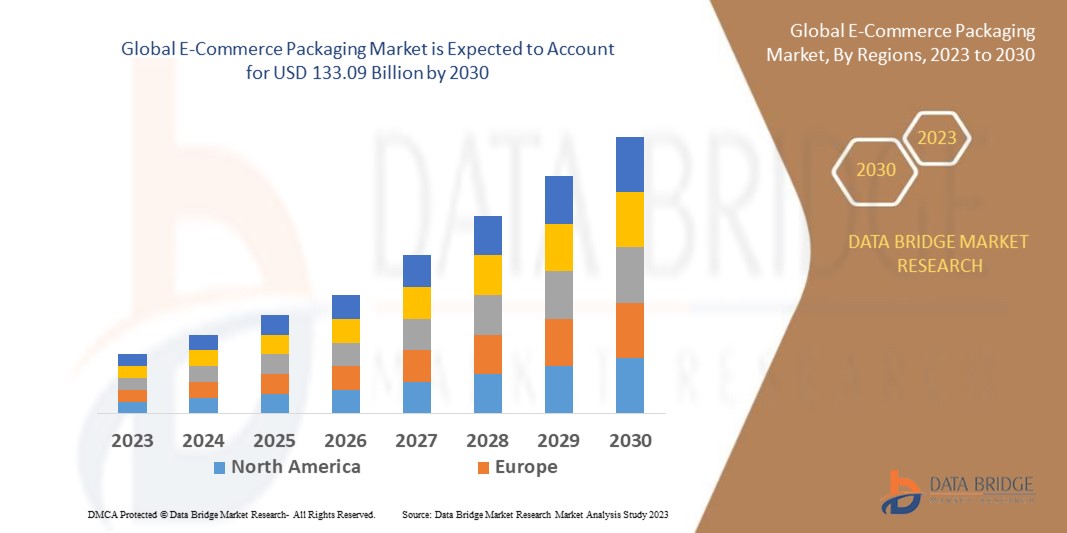Introduction
In the ever-evolving landscape of e-commerce, where packages traverse the digital realm to reach doorsteps around the globe, the role of packaging has transformed into a critical aspect of the customer experience. This guest post is a journey through the intricate world of the global e-commerce packaging market, exploring its evolution, examining current market trends, understanding the factors propelling its growth, and providing insights into the market scope and size. We’ll conclude our exploration with a detailed country-level analysis, uncovering the diverse and dynamic facets of e-commerce packaging across the world.
The Evolution
E-commerce packaging has come a long way from the simple brown boxes of yesteryear. As the digital marketplace expanded, so did the need for packaging that not only protects products but also aligns with sustainability goals and enhances the overall brand image.
The evolution of e-commerce packaging can be traced to the early days of online retail when standard cardboard boxes dominated. Today, however, it encompasses a spectrum of materials, designs, and functionalities. From eco-friendly packaging options to personalized branding experiences, the evolution reflects a shift in consumer expectations and a commitment to more sustainable practices.
E-Commerce Packaging Market Trends and Factors Driving Growth
The global e-commerce packaging market is shaped by trends that mirror the dynamic nature of online retail, environmental consciousness, and the pursuit of a seamless customer journey.
- Sustainable Packaging Practices: A notable trend is the increasing demand for sustainable packaging solutions. Brands are adopting eco-friendly materials, optimizing packaging dimensions to reduce waste, and exploring innovations like compostable and biodegradable options.
- Customization and Branding: E-commerce packaging is becoming an extension of a brand’s identity. Customized packaging, including branded boxes, tissue paper, and stickers, enhances the unboxing experience and fosters brand loyalty.
- Emphasis on Last-Mile Efficiency: As the last mile becomes a critical battleground for e-commerce giants, packaging is evolving to enhance delivery efficiency. Innovations such as compact packaging, smart packaging, and reusable options are gaining traction.
- Rise of Protective and Smart Packaging: The protection of goods during transit is paramount. The market has seen a surge in protective packaging solutions, including bubble mailers, air pillows, and smart packaging with tracking features for real-time monitoring.
- Regulatory Compliance and EPR Initiatives: Governments and regulatory bodies are increasingly focusing on sustainable packaging practices. Extended Producer Responsibility (EPR) initiatives, along with regulations on single-use plastics, are influencing how companies approach their e-commerce packaging strategies.
Market Scope and Market Size
The market scope of e-commerce packaging is expansive, covering a wide range of materials, formats, and functionalities. From standard shipping boxes and bubble mailers to innovative designs that prioritize sustainability and aesthetics, e-commerce packaging caters to the diverse needs of retailers and consumers alike.
The market size for e-commerce packaging is substantial and growing. With the continuous rise of online shopping, the demand for efficient, cost-effective, and environmentally friendly packaging solutions is on the ascent.
indicates a positive Compound Annual Growth Rate (CAGR) in the global e-commerce packaging market, underscoring its integral role in the e-commerce ecosystem.
Country Level Analysis
E-commerce packaging practices vary across countries, influenced by local regulations, consumer preferences, and the maturity of the e-commerce market.
- United States: In the U.S., e-commerce giants are driving innovations in packaging. The focus is on sustainability, with a shift towards recyclable and biodegradable materials. Customized and branded packaging is prevalent, contributing to a positive unboxing experience for consumers.
- China: As a global e-commerce powerhouse, China has a robust e-commerce packaging market. The emphasis is on efficient and protective packaging to accommodate the vast number of parcels generated by the country’s booming online retail sector.
- Germany: Germany, known for its environmentally conscious practices, places a strong emphasis on sustainable e-commerce packaging. Reusable and recyclable materials are favored, aligning with the country’s commitment to reducing environmental impact.
- India: In India, where e-commerce is experiencing rapid growth, the packaging landscape is evolving. Brands are adopting eco-friendly materials, and there is a focus on optimizing packaging to reduce waste and improve last-mile efficiency.
- United Kingdom: The UK’s e-commerce packaging market reflects a commitment to sustainability and regulatory compliance. Brands are adopting circular economy principles, and there is an increasing focus on minimizing packaging waste in line with EPR initiatives.
Packaging Perfection: The E-Commerce Revolution Unboxed for Safety, Sustainability, and Brand Brilliance
In the realm of online retail, e-commerce packaging proves to be a versatile and indispensable element, fulfilling several crucial roles. It serves to safeguard products during transit, presents opportunities for branding. Ensures cost-effectiveness in logistics, and contributes to an enhanced overall customer experience. The benefits of e-commerce packaging extend to product protection, the establishment of brand recognition and loyalty, logistical optimization for cost efficiency, consumer convenience, adherence to environmental considerations through sustainable practices, and the incorporation of security features. The varied materials utilized in e-commerce packaging are chosen to meet the unique requirements of products while aligning with sustainability objectives.




